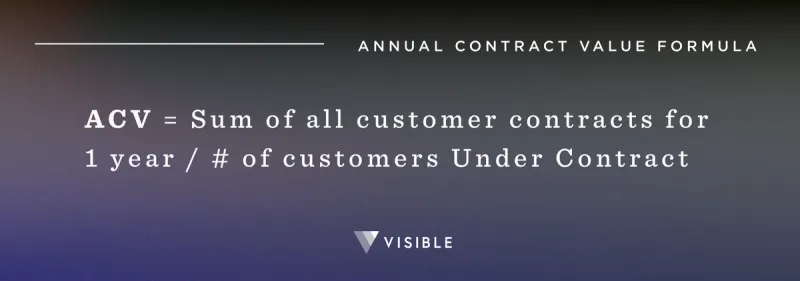Annual Contract Value (ACV) Defined
Annual contract value (ACV) is the average revenue per customer over a given year. ACV tends to be best for companies with recurring revenue.
For example, if you have 200 customers on average paying $1,000 a month, the ACV is $12,000 ($1,000 x 12 months). Learn more about how to calculate, track, and make decisions using ACV below.
Calculating Annual Contract Value
One of the tricky aspects of calculating and tracking ACV is that there is no hard-set rule or formula. Different businesses will calculate ACV in different ways. The main differences are between what is and is not included.
For example, let’s use our example from above — a company has an ACV of $12,000. This is straightforward and easy to get to with customers paying $1,000 a month on average.
However, let’s say that they also include a $2,000 setup fee (or any one-time fee). Some companies might include this in their ACV, while others don’t. It all comes down to the business and what they believe is best for them.
All in all, find the calculation that works best for your business and stick with it from month to month. Plus, make sure that your investors and team members are aware of how it is calculated and tracked.
Annual Contract Value Formula
At the core, annual contract value can be calculated by taking the sum of all customer contracts for 1 year and dividing it by the # of customers under contract. As we mentioned before, this is generally best suited for SaaS businesses.
ACV = Sum of all customer contracts for 1 year / # of customers Under Contract

For example, let’s say we have $120,000 in customer contracts for a year and 100 customers under contract. Our ACV would be $1,200 ($120,000/100 customer).
Learn more about why you should track your annual contract value below:
Why is Annual Contract Value Important?
For SaaS companies, tracking annual contract value is vital to understanding your acquisition efforts and go-to-market strategy.
Better decision making on Acquisitions
At the end of the day, your business needs to generate revenue and a profit. Understanding your ACV will better help you determine your acquisition and pricing strategy. Are you going to search for higher contract customers but less volume? Or lower contract customers at high volume?
Determining your pricing and acquisition strategy will have ultimately touch every decision you make when it comes to building products, hiring, fundraising, etc. For example, a lower contract product might require a more self-service product whereas a higher contract product might require a more hands-on approach from sales and team members.
Calculating ACV can help with sales and marketing
As we mentioned before, your ACV will determine your sales and marketing strategy. For a product with lower ACV, your strategy will require scale and volume. You need to make sure that your sales and marketing motions are repeatable as you are adding on a higher volume of customers. Buyers will likely have little to no interaction with the sales team. Instead, you might have a more robust marketing organization that can bring in new leads at scale.
On the flip side, a higher ACV might warrant spending more to acquire a single customer. Because the volume is lower you can take a more tailored and custom approach to new customers. You might have a more robust sales organization that warrants spending more to acquire a single customer.
Determining Your ACV Strategy
Determining your ACV strategy will impact every aspect of your business. We break down 2 different examples below to show how ACV will impact your customer makeup if you want to achieve $1M in ARR.
Small ACV Strategy
To start, let’s say we want to land at $1M in annual recurring revenue (ARR). There are quite a few different ways to get there. For our first example, let’s say that we have a small ACV — companies are paying us on average $500 a year. That means that we’ll need roughly 2,000 customers ($1,000,000 in revenue / $500 ACV). 2,000 customers means you’ll need a scalable marketing playbook to fill your top of funnel.
As you’ll need to service 2,000 customers, this means you’re product should be user-friendly and have the resources someone needs to support themselves (knowledge base, videos, guides, etc.).
Large ACV Strategy
On the flip side, let’s take the example from above ($1M in ARR) but with a higher ACV. Let’s say that we have an ACV of $10,000. That means that we’ll need roughly 100 customers. Because of the higher contract size, there are likely fewer customers that fit the mold so you will need to spend more to find and nurture your ideal customers.
Because customers will be spending $10k a year they will expect a more hands-on approach from your team. This means you might need a dedicated account manager, or recurring performance check-ins, etc.
Related Reading: Roundup: The Importance of SDRs
Tips on Increasing Annual Contract Value
Naturally, you might be thinking, “How do I increase our ACV?” Check out a few tips and examples for increasing ACV below:
Consider upselling/cross-selling
The first place to start is generally with upselling. As the team at BigCommerce puts it, “Upselling is the practice of encouraging customers to purchase a comparable higher-end product than the one in question, while cross-selling invites customers to buy related or complementary items.”
For SaaS products, this generally means using paywalls and different pricing plans. For example, one plan might cost $99/mo but if you want additional feature sets you can upgrade to a plan that costs $199/mo. Understanding where the value in your product lies is crucial to determining future product features and pricing plans.
Increase current prices
Simply put, you can increase your price as a whole. There are considerations to be made when increasing pricing but can be worthy of a test for your business. According to Harry Beckwith, author of Selling the Invisible, 15 to 20 percent of people should resist your pricing. Yes, even in the startup stage.
Narrow in on marketing and sales
Your marketing and sales efforts can also be a way to increase your ACV. Every interaction someone has with your business matters. The sum of these interactions is ultimately your brand. For companies with a strong brand, they can likely increase ACV based solely on the positive experiences your customers (or potential customers) have had with your brand.
Related Reading: How to Determine if Your Channel Partners are Actually Working
Put the Customer First
Having a strong customer experience is a surefire way to increase your ACV. At the end of the day if a customer is not pleased with your product or service they won’t feel the desire to upgrade or pay more in future years. By putting your customer first, you are giving yourself better odds of future upsells and expansion.
How to track your ACV
Tracking and taking action on your ACV is vital for a SaaS business to succeed. Give Visible a try to help your track your ACV and other key SaaS Metrics. Give it a try here.




